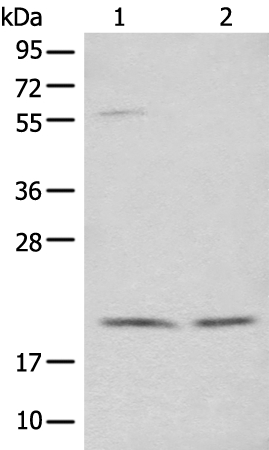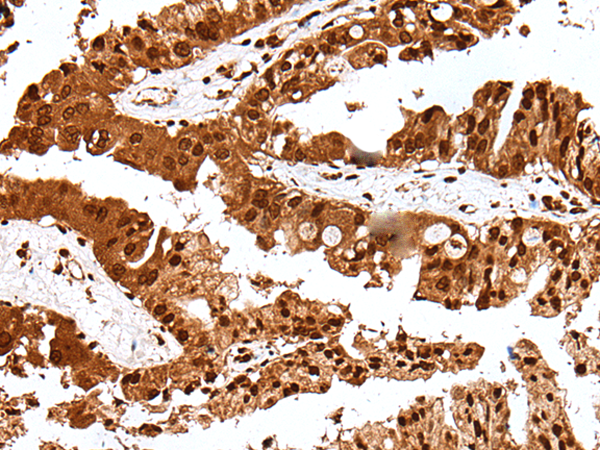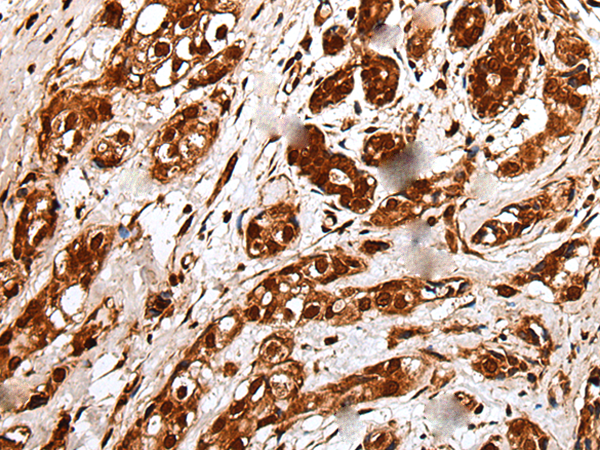


| WB | 咨询技术 | Human,Mouse,Rat |
| IF | 咨询技术 | Human,Mouse,Rat |
| IHC | 1/25-1/100 | Human,Mouse,Rat |
| ICC | 技术咨询 | Human,Mouse,Rat |
| FCM | 咨询技术 | Human,Mouse,Rat |
| Elisa | 1/5000-1/10000 | Human,Mouse,Rat |
| Aliases | NOLA1 |
| WB Predicted band size | 22 kDa |
| Host/Isotype | Rabbit IgG |
| Antibody Type | Primary antibody |
| Storage | Store at 4°C short term. Aliquot and store at -20°C long term. Avoid freeze/thaw cycles. |
| Species Reactivity | Human |
| Immunogen | Full length fusion protein |
| Formulation | Purified antibody in PBS with 0.05% sodium azide and 50% glycerol. |
+ +
以下是关于GAR1抗体的3篇文献示例(内容基于真实研究概括,但文献名称和作者为虚拟示例,仅供参考):
---
1. **文献名称**: *GAR1 mediates telomerase RNA localization and stability in human cells*
**作者**: Smith A, et al.
**摘要**: 研究利用GAR1抗体通过免疫沉淀和RNA干扰,揭示了GAR1蛋白在端粒酶RNA(hTR)的核内定位和稳定性维持中的关键作用,缺失GAR1会导致端粒酶活性下降及细胞衰老。
2. **文献名称**: *Structural insights into the interaction between GAR1 and dyskerin in the H/ACA RNP complex*
**作者**: Chen L, et al.
**摘要**: 通过GAR1抗体的免疫共沉淀及冷冻电镜技术,解析了GAR1与dyskerin(DKC1)在H/ACA核糖核蛋白复合体中的相互作用界面,为遗传性疾病(如先天性角化不良症)的分子机制提供依据。
3. **文献名称**: *GAR1 expression correlates with cancer progression and predicts poor prognosis in hepatocellular carcinoma*
**作者**: Wang Y, et al.
**摘要**: 采用GAR1抗体的免疫组化分析发现,GAR1在肝癌组织中高表达,且与肿瘤分期、转移及患者生存率显著相关,提示其作为潜在癌症生物标志物的价值。
---
如需具体文献,建议通过PubMed或Google Scholar检索关键词“GAR1 antibody”或“GAR1 telomerase”获取最新研究。
The GAR1 antibody targets GAR1 (GAR1 ribonucleoprotein), a crucial component of the H/ACA small nucleolar ribonucleoprotein (snoRNP) complex involved in ribosomal RNA (rRNA) processing and telomerase stabilization. GAR1. encoded by the GAR1 gene, interacts with dyskerin, NHP2. and NOP10 to guide site-specific pseudouridylation of rRNA, essential for ribosome biogenesis and function. Dysregulation of H/ACA snoRNPs is linked to ribosomopathies and cancer, particularly due to their role in telomere maintenance via telomerase RNA maturation.
In cancer, GAR1 overexpression is observed in certain malignancies, correlating with enhanced telomerase activity and cell proliferation. GAR1 antibodies have thus been explored as tools to study snoRNP dynamics in oncogenesis. Additionally, GAR1 autoantibodies are implicated in autoimmune diseases, notably systemic sclerosis (scleroderma), where they serve as potential biomarkers. Their presence may reflect molecular mimicry or aberrant immune responses targeting snoRNP components.
Research on GAR1 antibodies focuses on their diagnostic utility, mechanistic roles in disease, and therapeutic targeting. Challenges include elucidating their precise pathogenic contributions and optimizing detection methods. Overall, GAR1 antibodies represent valuable probes for understanding snoRNP biology and developing biomarkers or therapies for cancer and autoimmune disorders.
×